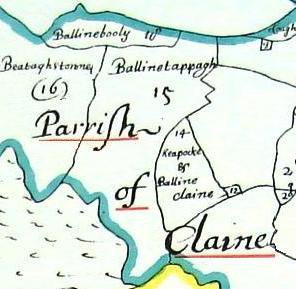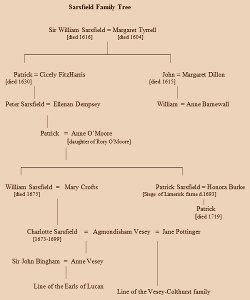Know your Townland – Ballinagappa
Published in Le Chéile April 2013
Many townlands in the area surrounding Clane have a rich historical past and one such townland is Ballinagappa which is situated about one and a half miles north west of Clane. The townland is highly fertile and suitable for tillage and this is reflected in how it got it’s name, with one source suggesting that it is derived from the term ‘the tillage district’.1 Most average townlands have very little detail surviving from the 17th century. However, Ballinagappa is the exception with substantial details surviving from this period mainly due to a land lease that dates from the reign of William of Orange in 1696. It was discovered in the archives and transcribed in 2005.2
Civil Survey 1654
Details also survive from the mid 17th century and the civil survey of 1654 shows that Ballinagappa then referred to as Ballynecappoge, had an area of 217 acres of which one hundred and sixty acres was described as arable, fourteen acres as meadow, thirty acres as pasture heath and ten acres as red bog. The measurement which was estimated was of Irish plantation measurement and bears little resemblance to the area of the townland at present. There were two landowners at the time in the townland. Three acres were held by Simon Luttrell of Luttrellstown and the remainder by William Sarsfield of Lucan. The value of Sarsfield’s land as they were let or worth to be let in the year 1640 was put at £24.

Ballinagappa in 1654
The only dwelling mentioned in the survey of Ballinagappa was a ruined Castle which had been destroyed in the ‘Wars of the of the 1640s’. This Castle was almost certainly the Tower house of Roger Penkeston which was built in 1465, and had been granted a subsidy of £10 from King Edward IV.3 A corn mill in Clane belonging to William Sarsfield is also mentioned in the survey and was described as ‘waste’ at that time.4 It was on the site of the ruined McCracken Mill close to Alexandra Bridge. Although very little of this mill is in existence today, a topographical study of earthworks in an area south of the mill in the late 1990s revealed low ditches where water from the weir on the Liffey was diverted to power the mill.5
Sarsfield lease 1696
Ballinagappa and the corn mill at Clane was still in the possession of the Sarsfield family during the 1690s and a lease from this period indicated that a number of changes to the landscape were contemplated. Certain conditions in the lease related to construction, drainage and enclosures.
The townland at the time was owned by Charlotte Sarsfield only daughter and heir of the late William Sarsfield of Lucan, county Dublin. William was the older brother of the famous Patrick Sarsfield.
In a letting agreement dating 15 September 1696, Charlotte Sarsfield demised and let to Benjamin Chetwood of the City of Dublin, ‘all that village or hamlet of land called Ballinagappa, containing two hundred and sixty eight acres profitable land Irish plantation measure together with all houses, edifices buildings, barns and stables on all or any part of the said demised premises for a term of twenty one years’. An annual rent of £60 sterling was to be paid half yearly on the first of May and the first of November every year. The lease was witnessed by two individuals named James Dwyer and John Coffey.
Conditions of the Lease
The lease was subject to a number of conditions. Within seven years the lessee Benjamin Chetwood was compelled to build on the estate a farm house consisting of ‘stone walls ten foot high with two gable ends and stone chimneys’. The house may not have been built as no house of this magnitude is shown in the townland on either Noble and Keenan's Map of 1752 or Taylor’s Map of 1783. The new occupier had to give an undertaking to keep the estate in good repair and not to plough or sow any part of the arable ground above three times without sufficient manure or lime first laid on the land in order to preserve the fertility of the soil. Furthermore, he was required to grind all the corn produced on the estate at the ‘Mill in Clane, commonly known as Sarsfields Mill’.
The lessee also gave an undertaken to enclose fields. Firstly, one acre of land was to be enclosed for an orchard and fenced with a ditch and quickset-thorn hedging. The occupier was even directed that the orchard should be planted with certain varieties of good apple trees. Additional tree planting was to be carried out by the first day of May in every year throughout the lifetime of the lease. This included: fifty young saplings; fifty young oaks or elm or other timber trees in proper season of the year for planting and in convenient places on the estate. The occupier was required to preserve the trees and prevent cattle from damaging them. Probably of the most challenging requirement in the lease was a condition to plant quickset-thorn hedges on any ditches that the lessee shall construct during the term of the lease.6 It was always necessary to dig drains for drainage purposes but to sow hedging on every drain that was constructed was an additional burden. According to many historians the widespread construction of most of the field systems that are so common in rural Ireland today began in the Williamite period and early 18th century. The Ballinagappa lease of 1696 is evidence of the construction of early enclosures in the Clane area from the late 17th century. This was confirmed by Mark Mullally a student from the Archaeology Department of UCD who carried out topographical research in the townland of Ballinagappa for his MA thesis in 1999.
Details of Charlotte Sarsfield and her Descendents
Charlotte Sarsfield came from a family of rebels. Her great-grandfather Peter Sarsfield was outlawed for involvement in the Rebellion of 1641. Following the Cromwelliam re-conquest in the early 1650s both Peter and his cousin William Sarsfield lost their lands which included Ballinagappa and the corn mill in Clane but regained them in 1661. Peter’s son Patrick married Anne O’Moore daughter of Rory O'Moore the 1641 rebel leader. They had two sons, William and Patrick of the Siege of Limerick fame. William as the eldest son was heir to the Sarsfield estates. He married Mary Crofts who was an interesting Lady. She was the daughter of Lucy Walter a one time mistress of King Charles II.7 Although there has always been speculation that Mary Crofts was the natural daughter of the King, modern historians, discount this fact. Charlotte was the only surviving child from the union of William Sarsfield and Mary Crofts.
Shortly after the Ballinagappa lease was signed Charlotte married Agmondisham Vesey.8 Their daughter Anne Vesey married Sir John Bingham.9 A son of this marriage Sir Charles Bingham became Earl of Lucan when the title was revived in 1795. This title was first granted by King James II to Patrick Sarsfield, and became extinct in 1719 with the death on the continent of his son James Sarsfield the second Lord Lucan.10 Charlotte’s descendents, the Bingham family still holds the title Earl of Lucan. The 8th Lord Lucan today lives in London and is the son of the notorious Richard John Bingham the 7th Earl who disappeared in 1974 following the murder of his wife’s nanny. Agmondisham Vesey remarried after the death of Charlotte Sarsfield and the ownership of the Lucan estate and Ballinagappa passed to the heirs of his second marriage and ultimately to the Vesey-Colthurst family. This family continued to hold the freehold of Ballinagappa until the ‘Land Acts’ of the late 19th century.
- Hermnn Geissel, Shady roads to Clane, p. 100.
- The lease is written in 17th century English and was transcribed by Seamus Cullen.
- Tadgh O’Keeffe, ‘Tower Houses of the Pale’, in Oughterany Vol I, No II.
- Robert Simington, The Civil Survey AD 1654-56 Vol. VIII, County Kildare (Dublin, 1952) p. 149; Journal of the Kildare Archaeological Society, Vol, IV, p. 118; William Sarsfield died unmarried, his heir was his cousin Patrick Sarsfield Senior father of William and General Patrick.
- The topographical study was carried out by Hermann Geissel, Tony McEvoy and Seamus Cullen.
- National Archives of Ireland; Document D/3370; Sarsfield/Chetwood lease of 1696, consisting of 29 lines.
- Journal of the Kildare Archaeological Society, Volume IV, pp 118–20.
- Charlotte married, 26th February 1696 and died on 7th October 1699.
- Henrietta an older daughter married Colonel Caesar Colclough; Agmondisham Vesey remarried after the death of Charlotte Sarsfield and the ownership of the Lucan estate passed to the heirs of his second marriage and ultimately to the Vesey-Colthurst family.
- Journal of the Kildare Archaeological Society, Volume IV, pp 116, 119, 124.

